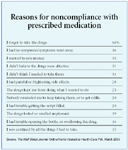Article
Patient compliance goes high-tech
The latest devices are designed to encourage patients to take their medicines.
Most physicians know that they can't count on patients taking their medications as directed. Some forget; some don't think they'll work; some don't follow the prescribed dosage; and some don't even bother to get the prescription filled. According to the American Pharmacists Association, up to 11 percent of hospital admissions, 40 percent of nursing home admissions, and about 125,000 deaths a year are due to noncompliance with prescribed medication regimens. As former US Surgeon General C. Everett Koop once lamented, "Drugs don't work in patients who don't take them."
Now a variety of high-tech devices can help jog patients' memories and encourage their compliance. Recognizing the limitations of the little plastic pillbox, and of human nature, enterprising companies have literally added bells and whistles to alert patients when it's time for their next dose of medicine. Here's a sample of what's currently available or coming soon:
• When MedPrompt ( http://www.medprompt.com) entered the patient compliance field 16 years ago, its "better mousetrap" was a cardboard slide designed to stick on the refrigerator. Now the company, based in Spring, TX, offers subscribers a reminder service via a programmed alphanumeric pager or other wireless device.
• Higher up the electronic evolutionary chain is OnTimeRx ( http://www.ontimerx.com), a reminder system for patients with handheld PDAs. It's marketed by an Orlando company that's also planning to launch a Web-based OnCellRx for cell phones and pagers.

"We've found that compliance is a big issue with this patient group," says brand manager Adria Nullmeier. "They want instant gratification, but with any acne product, they're not going to see results in a day. We found out that 40 percent of 12-to-14-year-olds and 75 percent of 15-to-17-year-olds have cell phones. So we figured that's a great way to reach them."
• Cell phones also play a central role in the SIMpill system, a wireless automated pill dispenser connected to a central wireless server. If the pill compartment is accessed on time, the server merely stores the data. But if the slot isn't opened on time, the server sends a text reminder to the patient's cell phone. If the compartment still isn't opened within a certain time frame, the server sends a message to the cell phone of another person designated to receive the e-alerts. Based in South Africa, the company's website is: http://www.simpill.com.
• Med-eMonitor, developed by Rock-ville, MD-based InforMedix ( http://www.informedix.com), combines compliance and disease management based on the individual patient's care plan. The system includes a portable drug storage device that uses chimes to prompt the patient to take her medication. It also asks the patient if she has taken the meds, monitors her health status by asking other questions, and records the time and date of all interactions.
At least once a day, the Med-eMonitor tells the patient, "Put me in my cradle," which automatically uploads the patient's stats to a central database. If any of that information is cause for concern, it triggers an outbound e-mail, page, or cell phone text message sent to the patient's doctor, or whoever else is designated to receive it.
The products described above constitute only a partial list of what's currently on the market, or on the way. Auburn University's Department of Pharmacy Care Systems has identified more than 160 different devices-some still under development-aimed at improving patient compliance.
But while technology can certainly improve drug compliance, it's no panacea. Many patients still need a human touch to encourage them. As Auburn professor Bill Felkey explains, "Research shows that the relationship between the patient and healthcare provider is one of the most, if not the most, important factors in predicting adherence."





